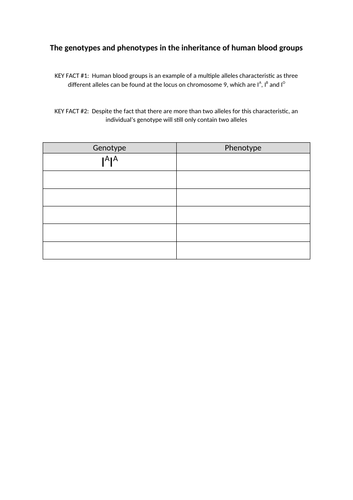





This fully-resourced lesson explores the inheritance of genetic characteristics that involve multiple alleles and codominant alleles. The engaging and detailed PowerPoint and differentiated worksheets have been designed to cover the part of point 6.1.2 (b[i]) which states that students should be able to demonstrate and apply their knowledge and understanding of genetic diagrams to show patterns of inheritance including multiple and codominant alleles.
The main part of the lesson uses the inheritance of the ABO blood groups to demonstrate how the three alleles that are found at the locus on chromosome 9 and the codominance of the A and B alleles affects the phenotypes. Students are guided through the construction of the different genotypes and how to interpret the resulting phenotype. They are challenged to use a partially completed pedigree tree to determine the blood group for some of the family members and to explain how they came to their answer. To further challenge their ability to apply their knowledge, a series of questions about multiple alleles and codominance in animals that are not humans are used.
The final part of the lesson makes a link back to module 4 and the correlation between a high proportion of polymorphic gene loci and an increase in genetic diversity. Students will be expected to make links between module 4 and 6 as part of papers 2 and 3, so this demonstrates how exam questions can do just that
Get this resource as part of a bundle and save up to 50%
A bundle is a package of resources grouped together to teach a particular topic, or a series of lessons, in one place.
Module 6.1.2: Patterns of inheritance (OCR A-Level Biology A)
Each of the 13 lessons included in this bundle are fully-resourced and have been designed to cover the content as detailed in module 6.1.2 (Patterns of inheritance) of the OCR A-Level Biology A specification. The specification points that are covered within these lessons include: * The contribution of environmental and genetic factors to phenotypic variation * How sexual reproduction can lead to genetic variation within a species * Genetic diagrams to show patterns of inheritance * The use of phenotypic ratios to identify autosomal and sex linkage and epistasis * Using the chi-squared test * The factors that can affect the evolution of a species * The use of the Hardy-Weinberg principle to calculate allele frequencies * The role of isolating mechanisms in the evolution of a new species The lessons have been written to include a wide range of activities and numerous understanding and prior knowledge checks so students can assess their progress against the current topic as well as be challenged to make links to other topics within this module and earlier modules.
Genetic diagrams and phenotypic ratios (OCR A-level Biology A module 6.1.2 [b])
Each of the 6 lessons within this bundle are fully-resourced and cover the content of point (b) of module 6.1.2 of the OCR A-level Biology A specification which states that students should be able to use genetic diagrams and phenotypic ratios to show patterns of inheritance and explain linkage and epistasis. Students are guided through the construction of the genetic diagrams for the inheritance of one or two genes and are shown how to analyse the phenotypic ratio to determine whether linkage has occurred or whether a gene interaction is involved. The wide range of activities which includes exam questions with visual mark schemes, differentiated tasks and quiz competitions will maintain engagement whilst providing the students with opportunities to assess their progress against the current topic.
Something went wrong, please try again later.
This resource hasn't been reviewed yet
To ensure quality for our reviews, only customers who have purchased this resource can review it
Report this resourceto let us know if it violates our terms and conditions.
Our customer service team will review your report and will be in touch.